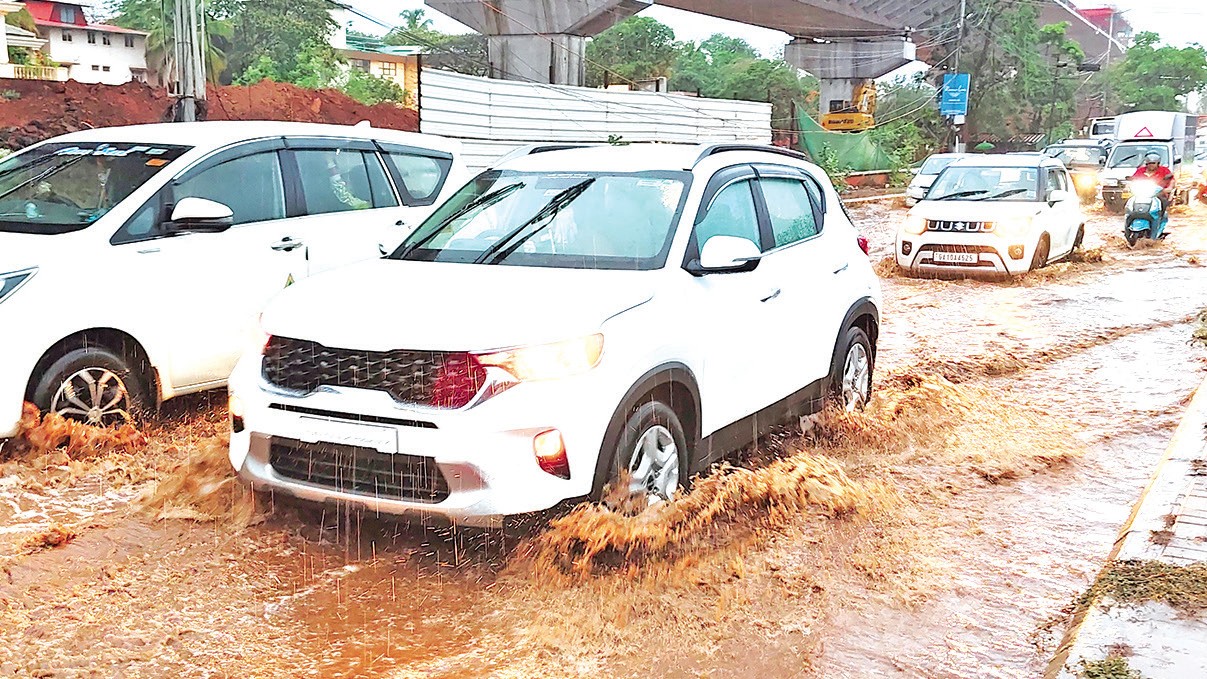Goa’s First Showers Expose Crumbling Civic Infrastructure in Arambol, Mapusa, and Margao
Team Herald
PANJIM/MARGAO: Drain Gratings on Panjim’s D B Road Pose Major Hazard to Two-Wheeler Riders
Arambol witnessed water stagnation near Ganesh Utsav Hall, with locals blaming the panchayat for poor drainage planning. In Pernem, overflowing drains pushed water onto the main roads, disrupting business and raising alarms over fragile civic infrastructure.
“Look at the condition of Ganapati Hall. Who is responsible for this? Where is the MLA? No one cares about the common people. Even the panchayat members haven’t shown up,” said Bharat Ghadi, a frustrated resident.
Another local, Suryakant Chodankar, pointed to specific lapses: “Drains weren’t cleaned properly. In many places, they were choked with plastic waste.”
“Even trees haven’t been pruned as they should have been.”
In Mapusa and Bicholim, low-lying markets were inundated, causing heavy losses to vendors. Flash floods in parts of Mapusa left business owners scrambling to save their stock. Margao too wasn’t spared — areas around the Kadamba Bus Stand, Old Station Road, Pajifond, Colmorod, and Arlem Highway saw widespread flooding. Roads became impassable, and daily life ground to a halt.
Despite the showers being moderate in volume, the city’s outdated drainage infrastructure was clearly overwhelmed. In many places, clogged drains and poor runoff systems resulted in waterlogging severe enough to trap vehicles and force pedestrians — especially the elderly — to wade through knee-deep water.
Shops in low-lying areas of the Old Market and Borda in Margao experienced minor flooding, damaging goods and forcing temporary closures. Two-wheeler riders and pedestrians bore the brunt of the deluge, many slipping or getting stranded in murky water.
In Fatorda, garbage-choked drains at the KTC bus stand led to severe waterlogging. The Madopa-Navelim and Moddi roads also saw water accumulation, making travel hazardous.
Across Salcete taluka — including Navelim, Benaulim, and Varca — inner roads and fields were flooded. Residents, already frustrated by years of neglect, said the authorities had ignored repeated calls for timely desilting and pre-monsoon preparations.
“It’s the same story every year. They wait for the city to flood before starting the clean-up. What were they doing all summer?” questioned Rodney Fernandes from Navelim.
In Canacona, flood-like conditions developed at the Ravindra Bhavan library, where water seeped through the ceiling and damaged books. Staff were seen mopping up the mess as rainfall continued. Roads were submerged in other areas like Valpoi and Dharagal, worsening mobility.
At the iconic Purumentache Fest, traditional dry fish vendors suffered losses as the rain kept customers away. Stalls remained stocked with unsold goods.
According to the IMD Goa, rainfall recorded between 8:30 am and 5:30 pm on May 20 was significant in several regions: Pernem (6.33 inches), Mapusa (6.18 inches), Panjim (3.1 inches), Mormugao (2.9 inches), Valpoi (1.69 inches), Sanguem (1.65 inches), Quepem (1.5 inches), and Ponda (1.1 inches).
The IMD has issued an orange alert for May 21, warning of very heavy to heavy rainfall at isolated locations across North and South Goa, along with thunderstorms and winds gusting up to 50–60 kmph.
With the official monsoon still ahead, Tuesday’s showers have raised urgent concerns about the state's readiness to face sustained rainfall. If this early downpour is any indication, Goa’s citizens could be in for a long and difficult monsoon season.

